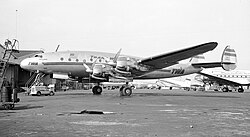This article needs additional citations for verification .(July 2013) |
 A TWA Lockheed L-049, similar to the aircraft involved in the accident | |
| Accident | |
|---|---|
| Date | July 11, 1946 |
| Summary | In-flight fire |
| Site | Bern Township, Pennsylvania, U.S. 40°24′58″N75°59′29″W / 40.41611°N 75.99139°W |
| Aircraft | |
| Aircraft type | Lockheed L-049 Constellation |
| Aircraft name | Star of Lisbon |
| Operator | Transcontinental & Western Air |
| Registration | NC86513 |
| Occupants | 6 |
| Crew | 6 |
| Fatalities | 5 |
| Injuries | 1 |
| Survivors | 1 [1] |
TWA Flight 513, registration NC86513, Star of Lisbon, was a Lockheed L-049 Constellation operated by Transcontinental and Western Air on a training flight on July 11, 1946, near Reading, Pennsylvania.